Một phương pháp lặp hiện tìm điểm có chuẩn nhỏ nhất trên tập nghiệm của bài toán điểm bất động tách
Bài toán chấp nhận tách và bài toán bất đẳng thức biến phân có nhiều ứng
dụng quan trọng trong các lĩnh vực như xử lý tín hiệu, xử lý ảnh, điều khiển
tối ưu và nhiều lĩnh vực khác. Ở đây, chúng tôi quan tâm tới một bài toán
hai cấp, đó là bài toán tìm điểm có chuẩn nhỏ nhất trên tập nghiệm của bài
toán điểm bất động tách. Bài toán tìm điểm có chuẩn nhỏ nhất là trường
hợp riêng của bài toán bất đẳng thức biến phân, trong đó ánh xạ giá F là
ánh xạ đồng nhất của không gian Hilbert. Trong bài báo này, chúng tôi trình
bày một phương pháp lặp hiện để xấp xỉ nghiệm của bài toán trên. Phương
pháp được xây dựng dựa trên kết quả đã được trình bày bởi các tác giả Trần
Việt Anh và Lê Dũng Mưu năm 2016, đó là sự kết hợp giữa phương pháp
chiếu giải bất đẳng thức biến phân và phương pháp Krasnoselskii–Mann
giải bài toán điểm bất động của các ánh xạ không giãn. Định lý về sự hội
tụ mạnh của thuật toán được chứng minh. Ở cuối bài báo, chúng tôi trình
bày một ví dụ số để minh họa cho sự hội tụ của phương pháp.
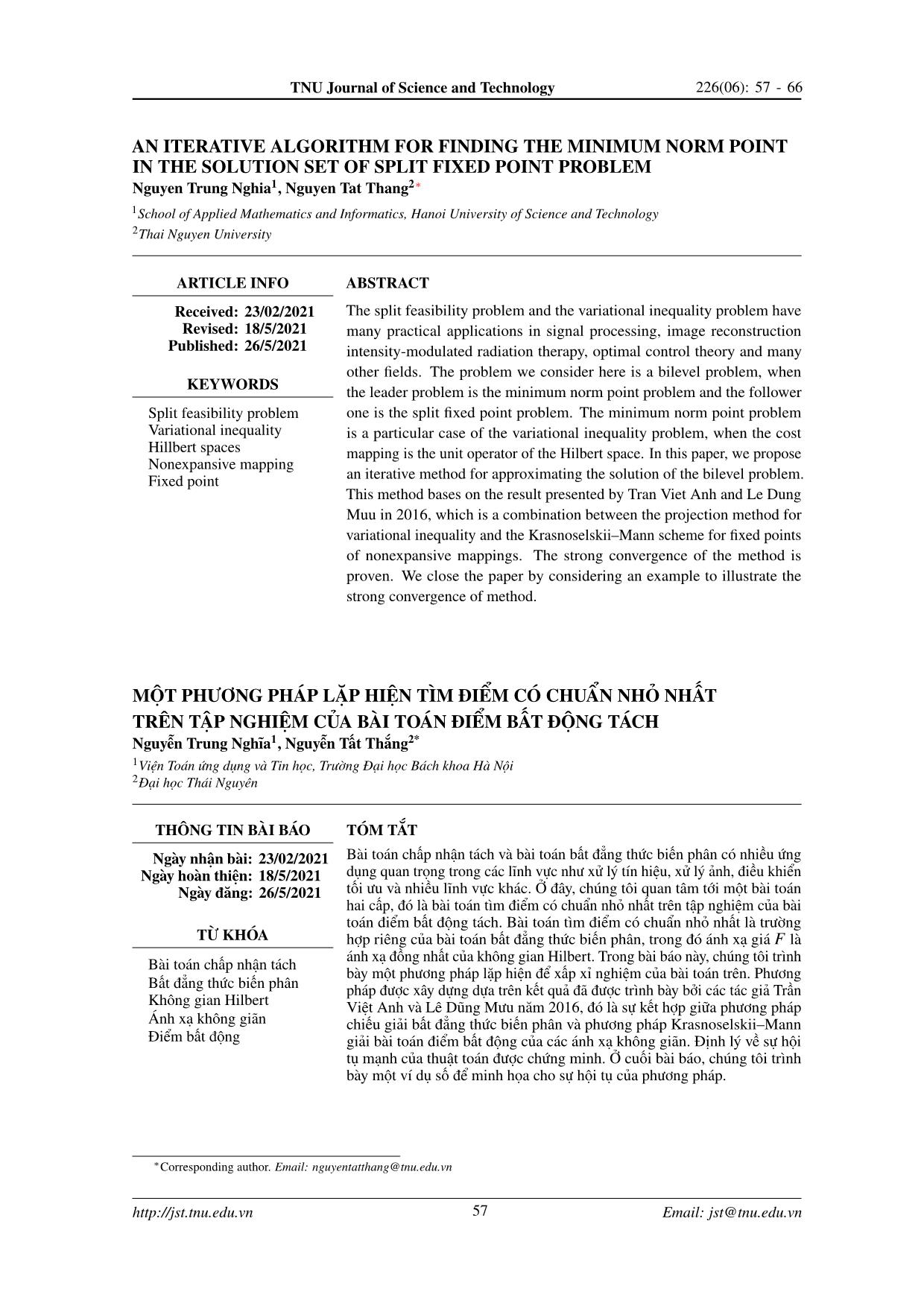
Trang 1
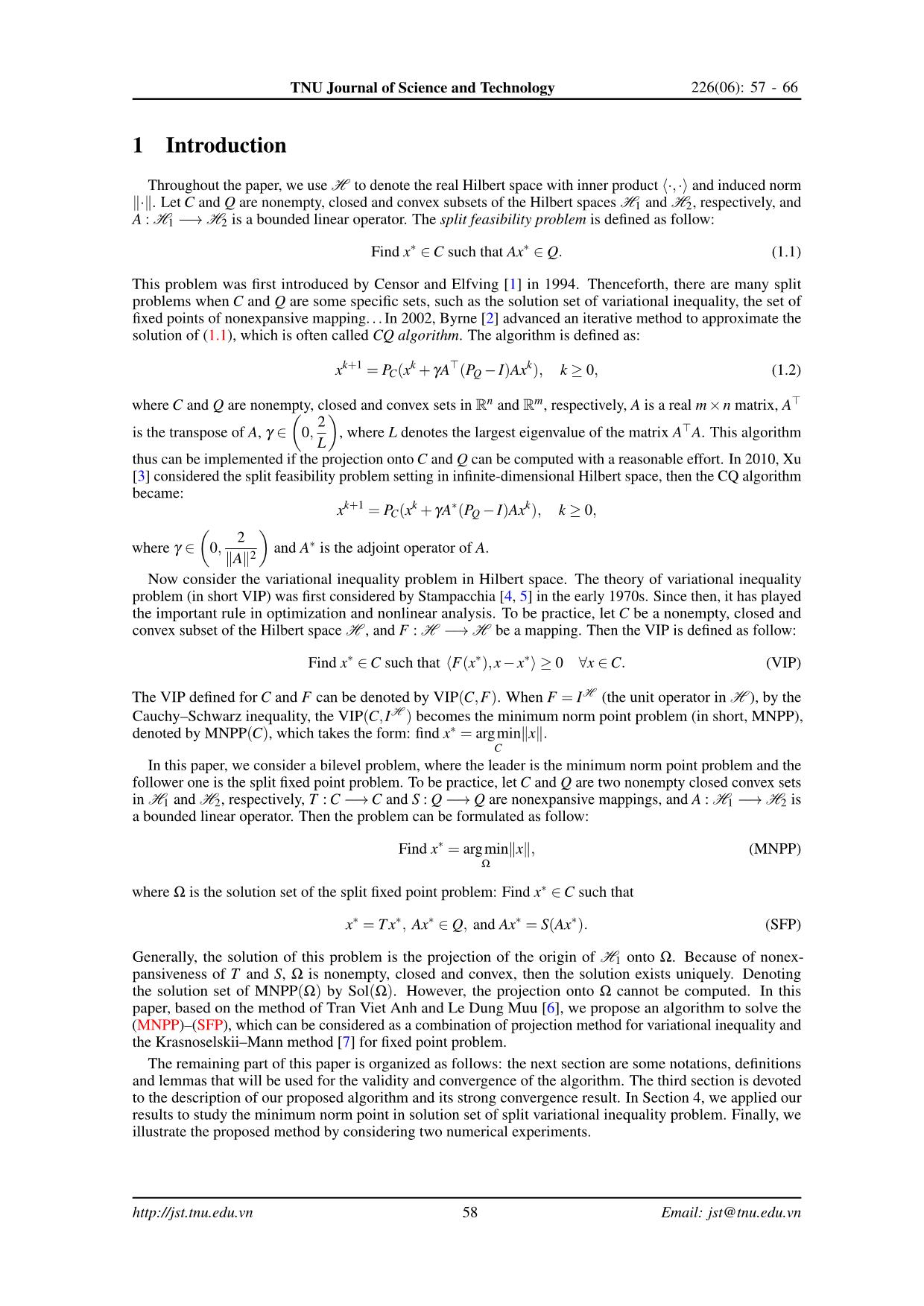
Trang 2
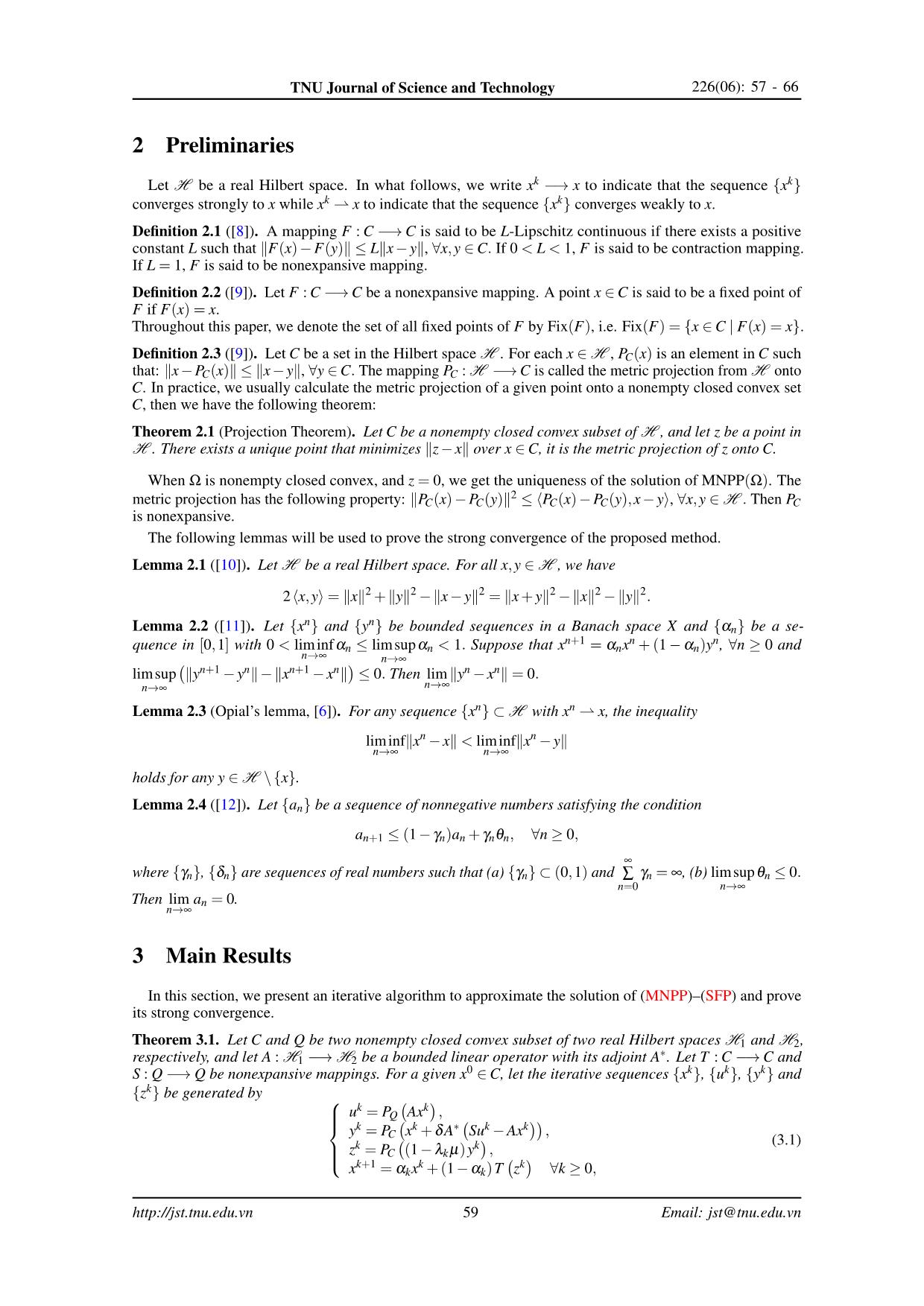
Trang 3
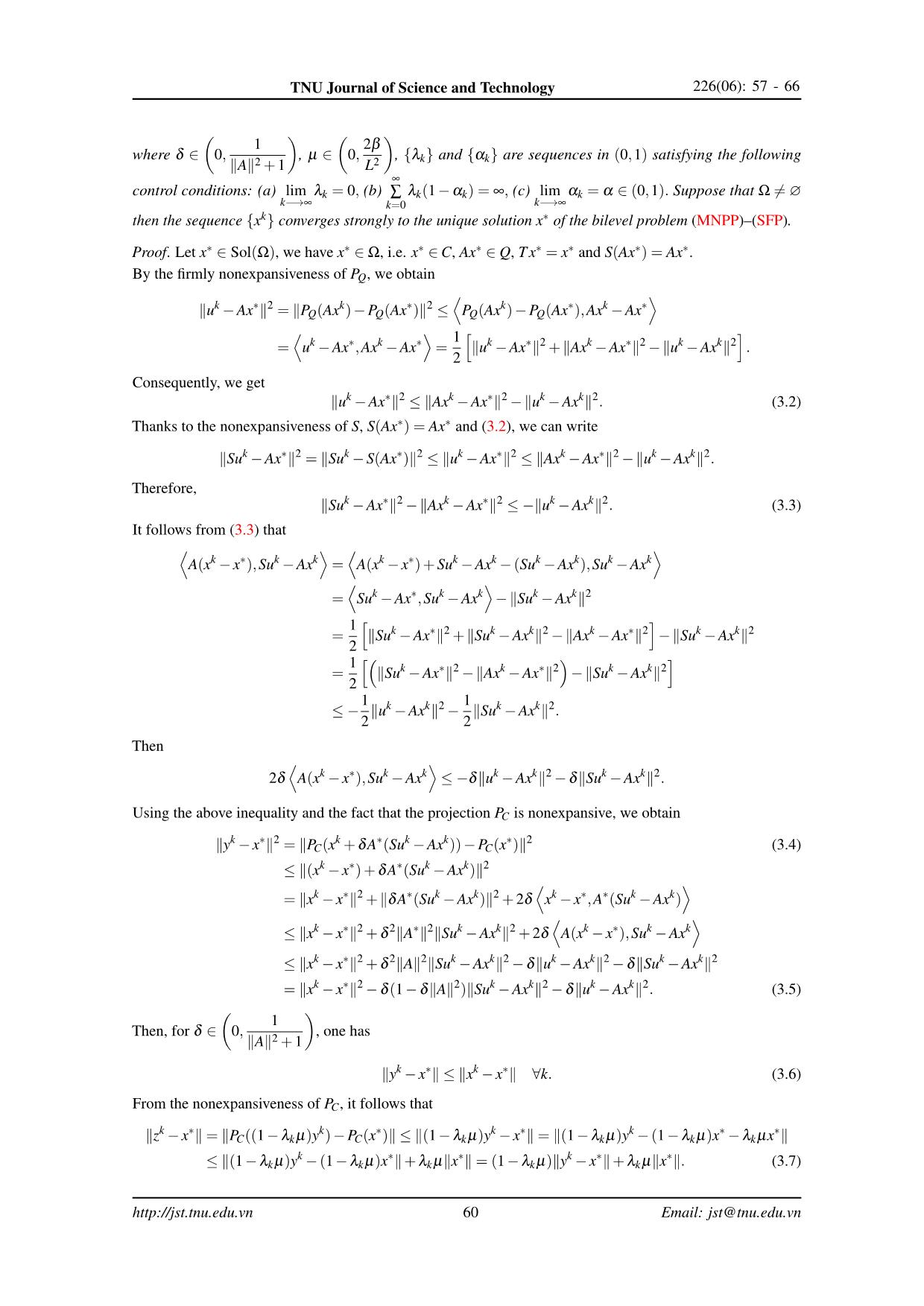
Trang 4
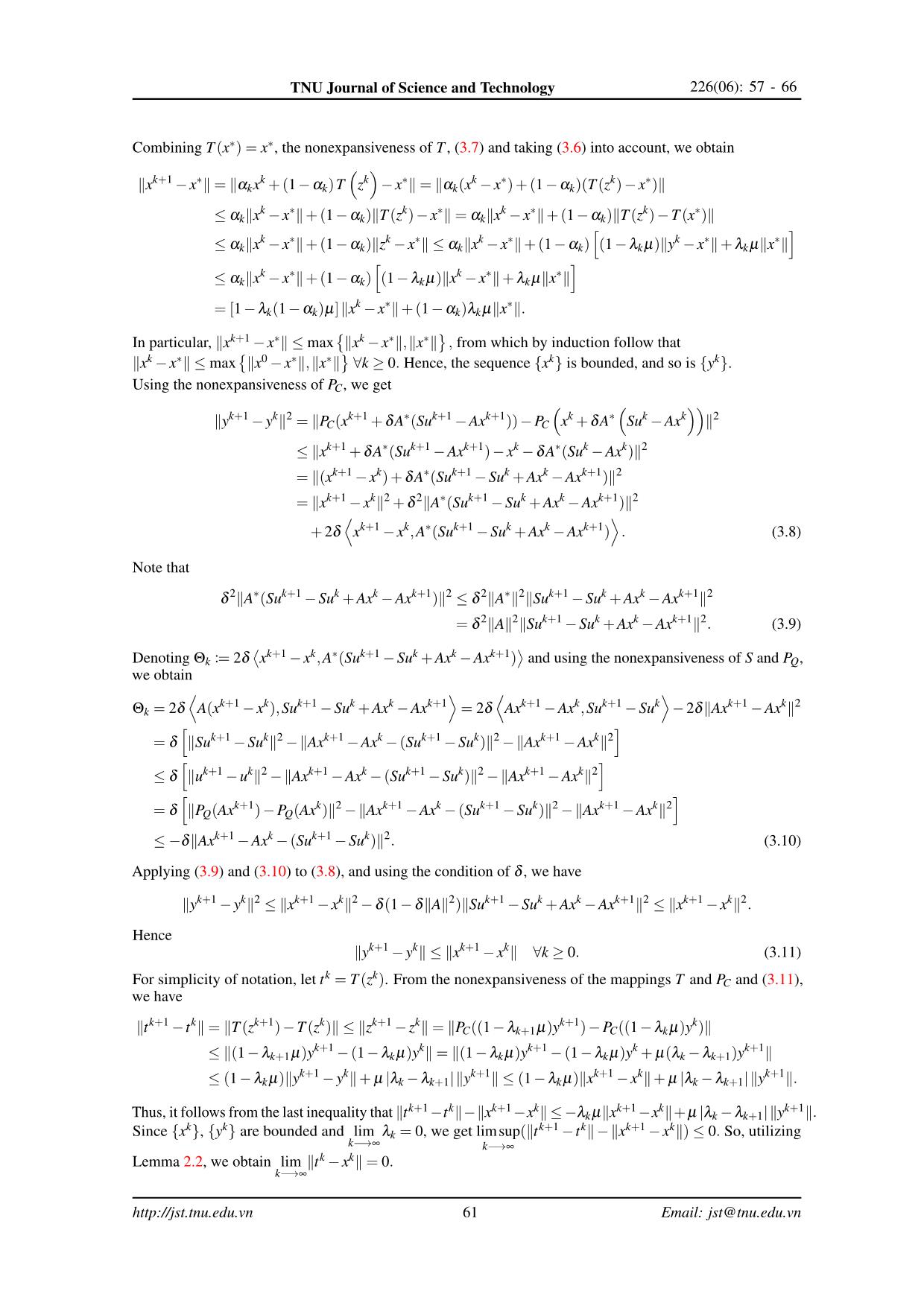
Trang 5
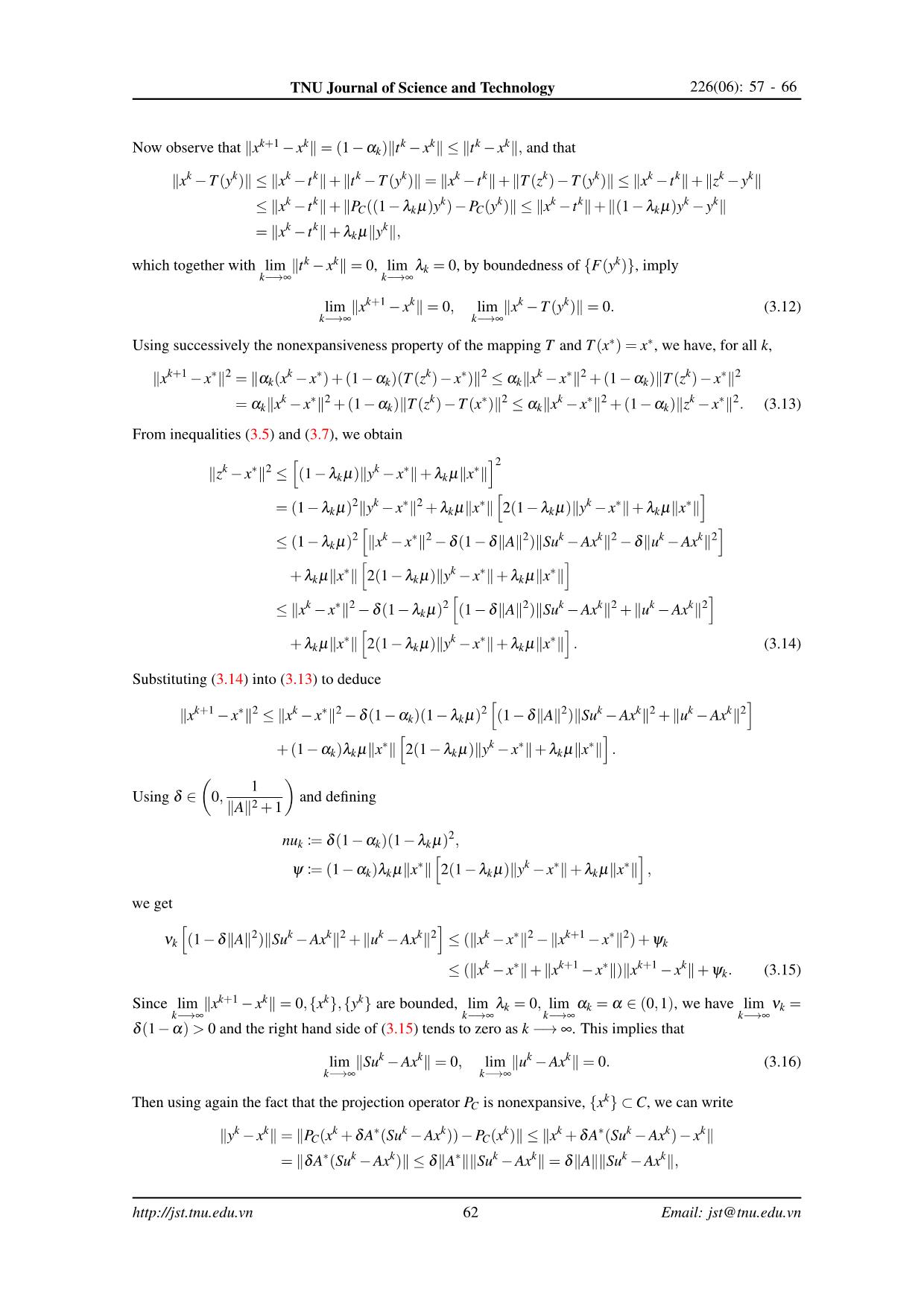
Trang 6
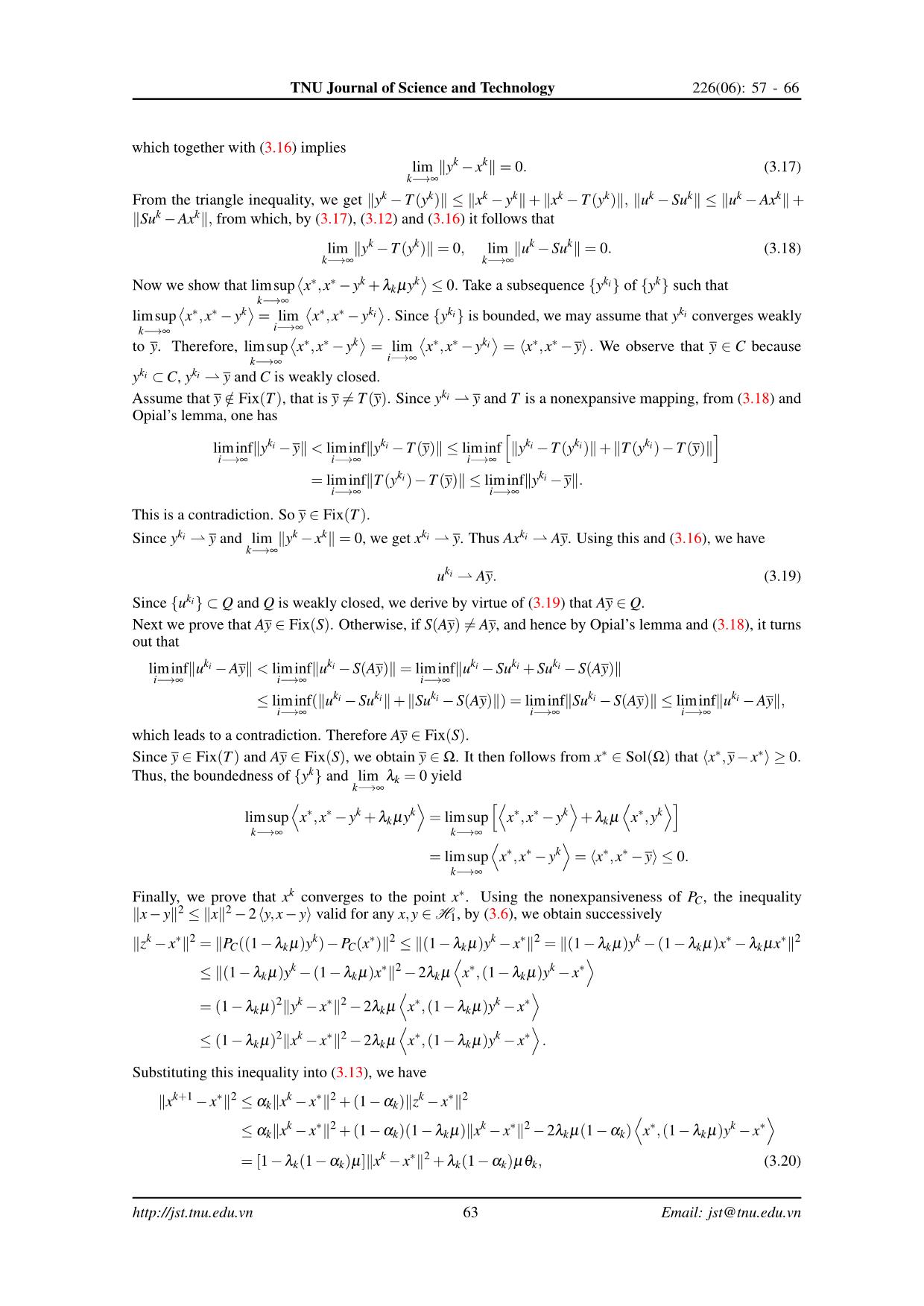
Trang 7
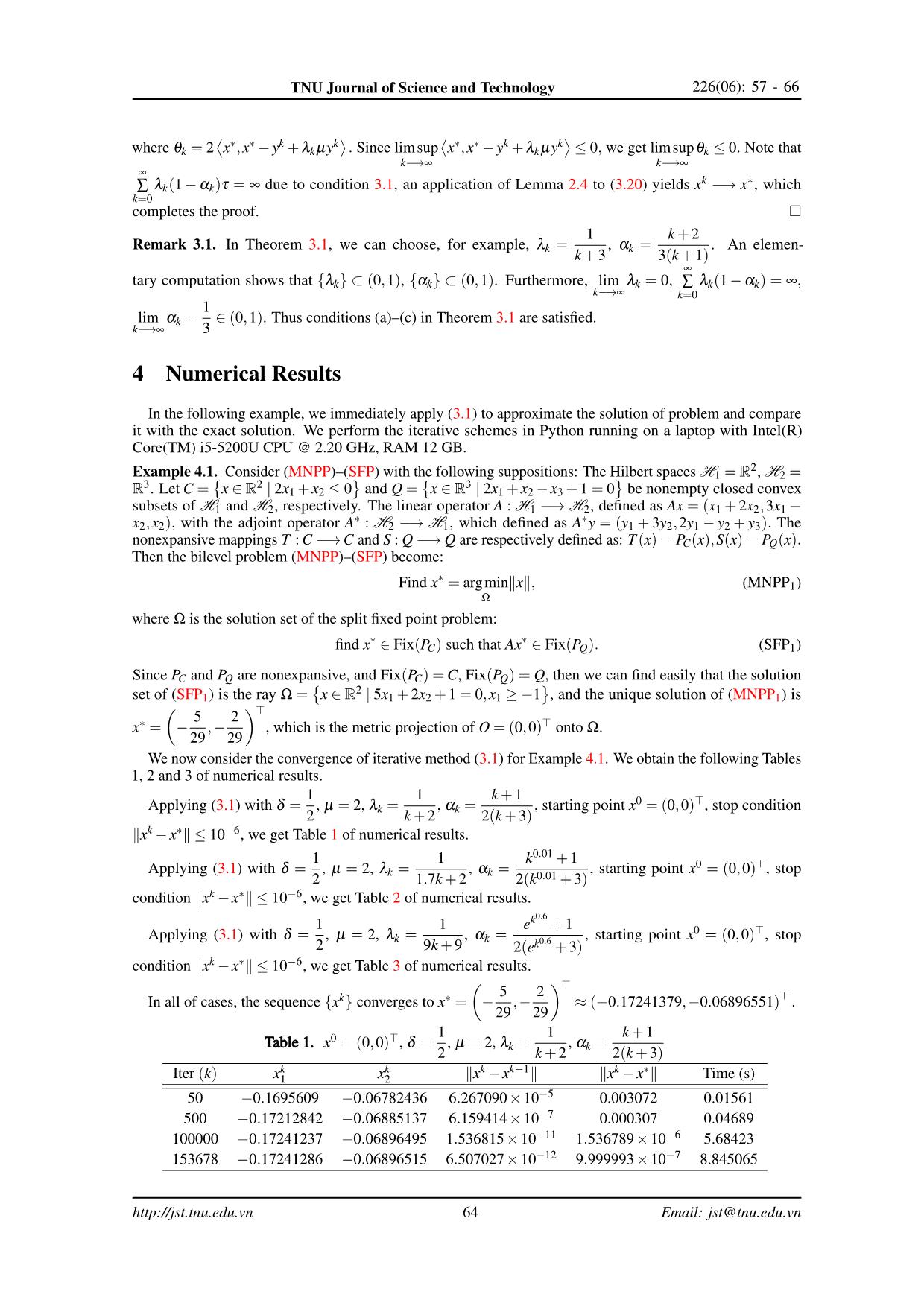
Trang 8

Trang 9
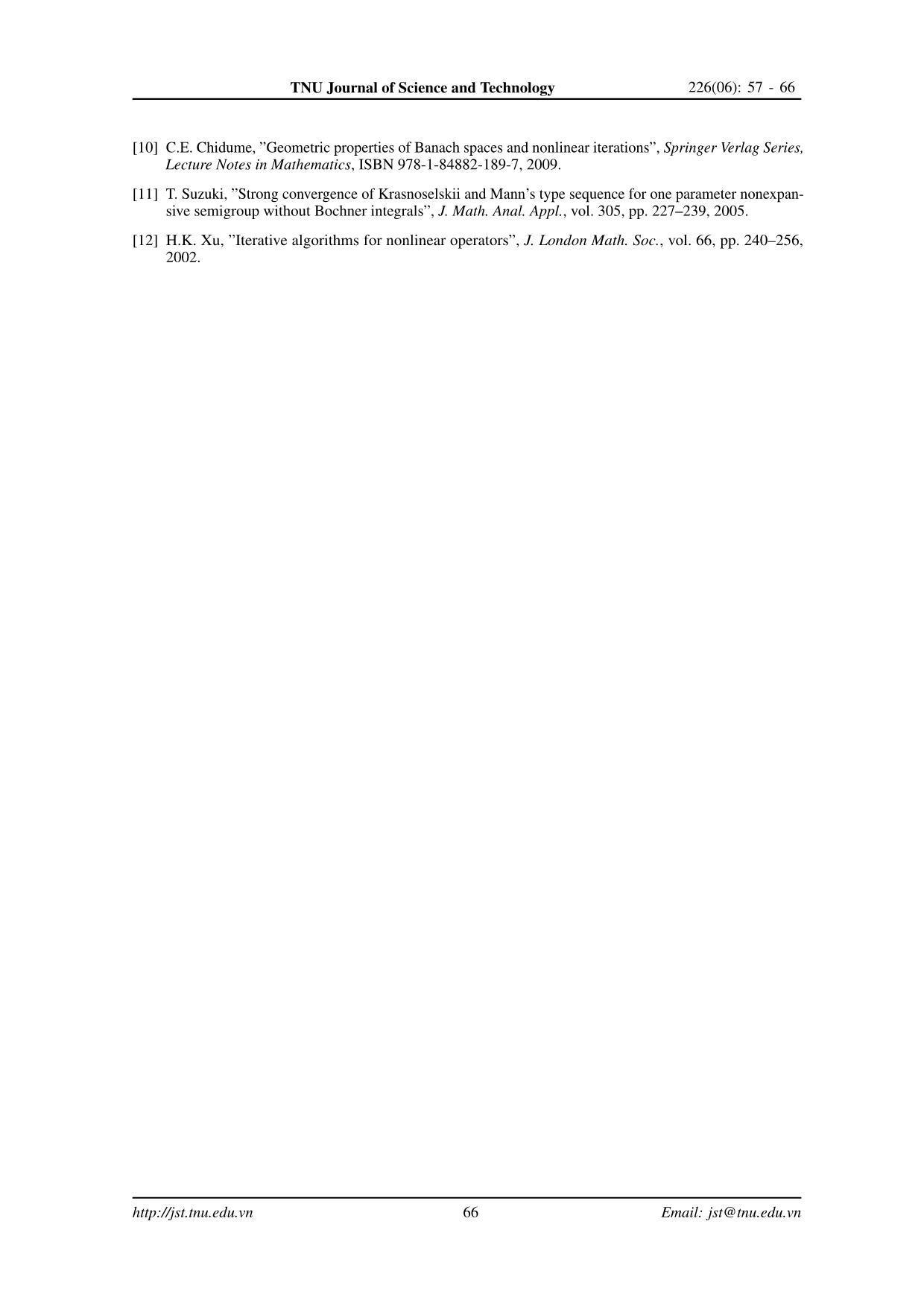
Trang 10
Tóm tắt nội dung tài liệu: Một phương pháp lặp hiện tìm điểm có chuẩn nhỏ nhất trên tập nghiệm của bài toán điểm bất động tách
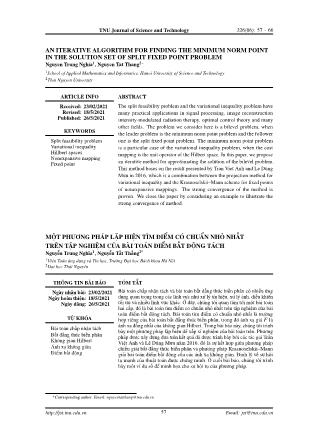
k ∗ ∗ k ∗ ∗
≤ k(1 − λkµ)y − (1 − λkµ)x k + λkµkx k = (1 − λkµ)ky − x k + λkµkx k. (3.7)
60 Email: jst@tnu.edu.vn
TNU Journal of Science and Technology 226(06): 57 - 66
Combining T(x∗) = x∗, the nonexpansiveness of T,(3.7) and taking (3.6) into account, we obtain
k+1 ∗ k k ∗ k ∗ k ∗
kx − x k = kαkx + (1 − αk)T z − x k = kαk(x − x ) + (1 − αk)(T(z ) − x )k
k ∗ k ∗ k ∗ k ∗
≤ αkkx − x k + (1 − αk)kT(z ) − x k = αkkx − x k + (1 − αk)kT(z ) − T(x )k
k ∗ k ∗ k ∗ h k ∗ ∗ i
≤ αkkx − x k + (1 − αk)kz − x k ≤ αkkx − x k + (1 − αk) (1 − λkµ)ky − x k + λkµkx k
k ∗ h k ∗ ∗ i
≤ αkkx − x k + (1 − αk) (1 − λkµ)kx − x k + λkµkx k
k ∗ ∗
= [1 − λk(1 − αk)µ]kx − x k + (1 − αk)λkµkx k.
In particular, kxk+1 − x∗k ≤ maxkxk − x∗k,kx∗k , from which by induction follow that
kxk − x∗k ≤ maxkx0 − x∗k,kx∗k ∀k ≥ 0. Hence, the sequence {xk} is bounded, and so is {yk}.
Using the nonexpansiveness of PC, we get
k+1 k 2 k+1 ∗ k+1 k+1 k ∗ k k 2
ky − y k = kPC(x + δA (Su − Ax )) − PC x + δA Su − Ax k
≤ kxk+1 + δA∗(Suk+1 − Axk+1) − xk − δA∗(Suk − Axk)k2
= k(xk+1 − xk) + δA∗(Suk+1 − Suk + Axk − Axk+1)k2
= kxk+1 − xkk2 + δ 2kA∗(Suk+1 − Suk + Axk − Axk+1)k2
D E
+ 2δ xk+1 − xk,A∗(Suk+1 − Suk + Axk − Axk+1) . (3.8)
Note that
δ 2kA∗(Suk+1 − Suk + Axk − Axk+1)k2 ≤ δ 2kA∗k2kSuk+1 − Suk + Axk − Axk+1k2
= δ 2kAk2kSuk+1 − Suk + Axk − Axk+1k2. (3.9)
k+1 k ∗ k+1 k k k+1
Denoting Θk := 2δ x − x ,A (Su − Su + Ax − Ax ) and using the nonexpansiveness of S and PQ,
we obtain
D k+1 k k+1 k k k+1E D k+1 k k+1 kE k+1 k 2
Θk = 2δ A(x − x ),Su − Su + Ax − Ax = 2δ Ax − Ax ,Su − Su − 2δkAx − Ax k
h i
= δ kSuk+1 − Sukk2 − kAxk+1 − Axk − (Suk+1 − Suk)k2 − kAxk+1 − Axkk2
h i
≤ δ kuk+1 − ukk2 − kAxk+1 − Axk − (Suk+1 − Suk)k2 − kAxk+1 − Axkk2
h k+1 k 2 k+1 k k+1 k 2 k+1 k 2i
= δ kPQ(Ax ) − PQ(Ax )k − kAx − Ax − (Su − Su )k − kAx − Ax k
≤ −δkAxk+1 − Axk − (Suk+1 − Suk)k2. (3.10)
Applying (3.9) and (3.10) to (3.8), and using the condition of δ, we have
kyk+1 − ykk2 ≤ kxk+1 − xkk2 − δ(1 − δkAk2)kSuk+1 − Suk + Axk − Axk+1k2 ≤ kxk+1 − xkk2.
Hence
kyk+1 − ykk ≤ kxk+1 − xkk ∀k ≥ 0. (3.11)
k k
For simplicity of notation, let t = T(z ). From the nonexpansiveness of the mappings T and PC and (3.11),
we have
k+1 k k+1 k k+1 k k+1 k
kt −t k = kT(z ) − T(z )k ≤ kz − z k = kPC((1 − λk+1µ)y ) − PC((1 − λkµ)y )k
k+1 k k+1 k k+1
≤ k(1 − λk+1µ)y − (1 − λkµ)y k = k(1 − λkµ)y − (1 − λkµ)y + µ(λk − λk+1)y k
k+1 k k+1 k+1 k k+1
≤ (1 − λkµ)ky − y k + µ |λk − λk+1|ky k ≤ (1 − λkµ)kx − x k + µ |λk − λk+1|ky k.
k+1 k k+1 k k+1 k k+1
Thus, it follows from the last inequality that kt −t k−kx −x k ≤ −λkµkx −x k+µ |λk − λk+1|ky k.
k k k+1 k k+1 k
Since {x }, {y } are bounded and lim λk = 0, we get limsup(kt −t k − kx − x k) ≤ 0. So, utilizing
k−→∞ k−→∞
Lemma 2.2, we obtain lim ktk − xkk = 0.
k−→∞
61 Email: jst@tnu.edu.vn
TNU Journal of Science and Technology 226(06): 57 - 66
k+1 k k k k k
Now observe that kx − x k = (1 − αk)kt − x k ≤ kt − x k, and that
kxk − T(yk)k ≤ kxk −tkk + ktk − T(yk)k = kxk −tkk + kT(zk) − T(yk)k ≤ kxk −tkk + kzk − ykk
k k k k k k k k
≤ kx −t k + kPC((1 − λkµ)y ) − PC(y )k ≤ kx −t k + k(1 − λkµ)y − y k
k k k
= kx −t k + λkµky k,
k k k
which together with lim kt − x k = 0, lim λk = 0, by boundedness of {F(y )}, imply
k−→∞ k−→∞
lim kxk+1 − xkk = 0, lim kxk − T(yk)k = 0. (3.12)
k−→∞ k−→∞
Using successively the nonexpansiveness property of the mapping T and T(x∗) = x∗, we have, for all k,
k+1 ∗ 2 k ∗ k ∗ 2 k ∗ 2 k ∗ 2
kx − x k = kαk(x − x ) + (1 − αk)(T(z ) − x )k ≤ αkkx − x k + (1 − αk)kT(z ) − x k
k ∗ 2 k ∗ 2 k ∗ 2 k ∗ 2
= αkkx − x k + (1 − αk)kT(z ) − T(x )k ≤ αkkx − x k + (1 − αk)kz − x k . (3.13)
From inequalities (3.5) and (3.7), we obtain
2
k ∗ 2 h k ∗ ∗ i
kz − x k ≤ (1 − λkµ)ky − x k + λkµkx k
2 k ∗ 2 ∗ h k ∗ ∗ i
= (1 − λkµ) ky − x k + λkµkx k 2(1 − λkµ)ky − x k + λkµkx k
2 h k ∗ 2 2 k k 2 k k 2i
≤ (1 − λkµ) kx − x k − δ(1 − δkAk )kSu − Ax k − δku − Ax k
∗ h k ∗ ∗ i
+ λkµkx k 2(1 − λkµ)ky − x k + λkµkx k
k ∗ 2 2 h 2 k k 2 k k 2i
≤ kx − x k − δ(1 − λkµ) (1 − δkAk )kSu − Ax k + ku − Ax k
∗ h k ∗ ∗ i
+ λkµkx k 2(1 − λkµ)ky − x k + λkµkx k . (3.14)
Substituting (3.14) into (3.13) to deduce
k+1 ∗ 2 k ∗ 2 2 h 2 k k 2 k k 2i
kx − x k ≤ kx − x k − δ(1 − αk)(1 − λkµ) (1 − δkAk )kSu − Ax k + ku − Ax k
∗ h k ∗ ∗ i
+ (1 − αk)λkµkx k 2(1 − λkµ)ky − x k + λkµkx k .
1
Using δ ∈ 0, and defining
kAk2 + 1
2
nuk := δ(1 − αk)(1 − λkµ) ,
∗ h k ∗ ∗ i
ψ := (1 − αk)λkµkx k 2(1 − λkµ)ky − x k + λkµkx k ,
we get
h 2 k k 2 k k 2i k ∗ 2 k+1 ∗ 2
νk (1 − δkAk )kSu − Ax k + ku − Ax k ≤ (kx − x k − kx − x k ) + ψk
k ∗ k+1 ∗ k+1 k
≤ (kx − x k + kx − x k)kx − x k + ψk. (3.15)
k+1 k k k
Since lim kx − x k = 0,{x },{y } are bounded, lim λk = 0, lim αk = α ∈ (0,1), we have lim νk =
k−→∞ k−→∞ k−→∞ k−→∞
δ(1 − α) > 0 and the right hand side of (3.15) tends to zero as k −→ ∞. This implies that
lim kSuk − Axkk = 0, lim kuk − Axkk = 0. (3.16)
k−→∞ k−→∞
k
Then using again the fact that the projection operator PC is nonexpansive, {x } ⊂ C, we can write
k k k ∗ k k k k ∗ k k k
ky − x k = kPC(x + δA (Su − Ax )) − PC(x )k ≤ kx + δA (Su − Ax ) − x k
= kδA∗(Suk − Axk)k ≤ δkA∗kkSuk − Axkk = δkAkkSuk − Axkk,
62 Email: jst@tnu.edu.vn
TNU Journal of Science and Technology 226(06): 57 - 66
which together with (3.16) implies
lim kyk − xkk = 0. (3.17)
k−→∞
From the triangle inequality, we get kyk − T(yk)k ≤ kxk − ykk + kxk − T(yk)k, kuk − Sukk ≤ kuk − Axkk +
kSuk − Axkk, from which, by (3.17), (3.12) and (3.16) it follows that
lim kyk − T(yk)k = 0, lim kuk − Sukk = 0. (3.18)
k−→∞ k−→∞
∗ ∗ k k
k k
Now we show that limsup x ,x − y + λkµy ≤ 0. Take a subsequence {y i } of {y } such that
k−→∞
limsup
x∗,x∗ − yk
= lim
x∗,x∗ − yki
. Since {yki } is bounded, we may assume that yki converges weakly
k−→∞ i−→∞
to y. Therefore, limsup
x∗,x∗ − yk
= lim
x∗,x∗ − yki
= hx∗,x∗ − yi. We observe that y ∈ C because
k−→∞ i−→∞
yki ⊂ C, yki * y and C is weakly closed.
Assume that y ∈/ Fix(T), that is y 6= T(y). Since yki * y and T is a nonexpansive mapping, from (3.18) and
Opial’s lemma, one has
h i
liminfkyki − yk < liminfkyki − T(y)k ≤ liminf kyki − T(yki )k + kT(yki ) − T(y)k
i−→∞ i−→∞ i−→∞
= liminfkT(yki ) − T(y)k ≤ liminfkyki − yk.
i−→∞ i−→∞
This is a contradiction. So y ∈ Fix(T).
Since yki * y and lim kyk − xkk = 0, we get xki * y. Thus Axki * Ay. Using this and (3.16), we have
k−→∞
uki * Ay. (3.19)
Since {uki } ⊂ Q and Q is weakly closed, we derive by virtue of (3.19) that Ay ∈ Q.
Next we prove that Ay ∈ Fix(S). Otherwise, if S(Ay) 6= Ay, and hence by Opial’s lemma and (3.18), it turns
out that
liminfkuki − Ayk < liminfkuki − S(Ay)k = liminfkuki − Suki + Suki − S(Ay)k
i−→∞ i−→∞ i−→∞
≤ liminf(kuki − Suki k + kSuki − S(Ay)k) = liminfkSuki − S(Ay)k ≤ liminfkuki − Ayk,
i−→∞ i−→∞ i−→∞
which leads to a contradiction. Therefore Ay ∈ Fix(S).
Since y ∈ Fix(T) and Ay ∈ Fix(S), we obtain y ∈ Ω. It then follows from x∗ ∈ Sol(Ω) that hx∗,y − x∗i ≥ 0.
k
Thus, the boundedness of {y } and lim λk = 0 yield
k−→∞
D ∗ ∗ k kE hD ∗ ∗ kE D ∗ kEi
limsup x ,x − y + λkµy = limsup x ,x − y + λkµ x ,y
k−→∞ k−→∞
D E
= limsup x∗,x∗ − yk = hx∗,x∗ − yi ≤ 0.
k−→∞
k ∗
Finally, we prove that x converges to the point x . Using the nonexpansiveness of PC, the inequality
2 2
kx − yk ≤ kxk − 2hy,x − yi valid for any x,y ∈ H1, by (3.6), we obtain successively
k ∗ 2 k ∗ 2 k ∗ 2 k ∗ ∗ 2
kz − x k = kPC((1 − λkµ)y ) − PC(x )k ≤ k(1 − λkµ)y − x k = k(1 − λkµ)y − (1 − λkµ)x − λkµx k
k ∗ 2 D ∗ k ∗E
≤ k(1 − λkµ)y − (1 − λkµ)x k − 2λkµ x ,(1 − λkµ)y − x
2 k ∗ 2 D ∗ k ∗E
= (1 − λkµ) ky − x k − 2λkµ x ,(1 − λkµ)y − x
2 k ∗ 2 D ∗ k ∗E
≤ (1 − λkµ) kx − x k − 2λkµ x ,(1 − λkµ)y − x .
Substituting this inequality into (3.13), we have
k+1 ∗ 2 k ∗ 2 k ∗ 2
kx − x k ≤ αkkx − x k + (1 − αk)kz − x k
k ∗ 2 k ∗ 2 D ∗ k ∗E
≤ αkkx − x k + (1 − αk)(1 − λkµ)kx − x k − 2λkµ(1 − αk) x ,(1 − λkµ)y − x
k ∗ 2
= [1 − λk(1 − αk)µ]kx − x k + λk(1 − αk)µθk, (3.20)
63 Email: jst@tnu.edu.vn
TNU Journal of Science and Technology 226(06): 57 - 66
∗ ∗ k k
∗ ∗ k k
where θk = 2 x ,x − y + λkµy . Since limsup x ,x − y + λkµy ≤ 0, we get limsupθk ≤ 0. Note that
k−→∞ k−→∞
∞
k ∗
∑ λk(1 − αk)τ = ∞ due to condition 3.1, an application of Lemma 2.4 to (3.20) yields x −→ x , which
k=0
completes the proof.
1 k + 2
Remark 3.1. In Theorem 3.1, we can choose, for example, λ = , α = . An elemen-
k k + 3 k 3(k + 1)
∞
tary computation shows that {λk} ⊂ (0,1), {αk} ⊂ (0,1). Furthermore, lim λk = 0, ∑ λk(1 − αk) = ∞,
k−→∞ k=0
1
lim αk = ∈ (0,1). Thus conditions (a)–(c) in Theorem 3.1 are satisfied.
k−→∞ 3
4 Numerical Results
In the following example, we immediately apply (3.1) to approximate the solution of problem and compare
it with the exact solution. We perform the iterative schemes in Python running on a laptop with Intel(R)
Core(TM) i5-5200U CPU @ 2.20 GHz, RAM 12 GB.
2
Example 4.1. Consider (MNPP)–(SFP) with the following suppositions: The Hilbert spaces H1 = R , H2 =
3 2 3
R . Let C = x ∈ R | 2x1 + x2 ≤ 0 and Q = x ∈ R | 2x1 + x2 − x3 + 1 = 0 be nonempty closed convex
subsets of H1 and H2, respectively. The linear operator A : H1 −→ H2, defined as Ax = (x1 + 2x2,3x1 −
∗ ∗
x2,x2), with the adjoint operator A : H2 −→ H1, which defined as A y = (y1 + 3y2,2y1 − y2 + y3). The
nonexpansive mappings T : C −→ C and S : Q −→ Q are respectively defined as: T(x) = PC(x),S(x) = PQ(x).
Then the bilevel problem (MNPP)–(SFP) become:
∗
Find x = argminkxk, (MNPP1)
Ω
where Ω is the solution set of the split fixed point problem:
∗ ∗
find x ∈ Fix(PC) such that Ax ∈ Fix(PQ). (SFP1)
Since PC and PQ are nonexpansive, and Fix(PC) = C, Fix(PQ) = Q, then we can find easily that the solution
2
set of (SFP1) is the ray Ω = x ∈ R | 5x1 + 2x2 + 1 = 0,x1 ≥ −1 , and the unique solution of (MNPP1) is
5 2 >
x∗ = − ,− , which is the metric projection of O = (0,0)> onto Ω.
29 29
We now consider the convergence of iterative method (3.1) for Example 4.1. We obtain the following Tables
1, 2 and 3 of numerical results.
1 1 k + 1
Applying (3.1) with δ = , µ = 2, λ = , α = , starting point x0 = (0,0)>, stop condition
2 k k + 2 k 2(k + 3)
kxk − x∗k ≤ 10−6, we get Table 1 of numerical results.
1 1 k0.01 + 1
Applying (3.1) with δ = , µ = 2, λ = , α = , starting point x0 = (0,0)>, stop
2 k 1.7k + 2 k 2(k0.01 + 3)
condition kxk − x∗k ≤ 10−6, we get Table 2 of numerical results.
k0.6
1 1 e + 1 0 >
Applying (3.1) with δ = , µ = 2, λk = , αk = , starting point x = (0,0) , stop
2 9k + 9 2(ek0.6 + 3)
condition kxk − x∗k ≤ 10−6, we get Table 3 of numerical results.
5 2 >
In all of cases, the sequence {xk} converges to x∗ = − ,− ≈ (−0.17241379,−0.06896551)> .
29 29
1 1 k + 1
Table 1. x0 = (0,0)>, δ = , µ = 2, λ = , α =
2 k k + 2 k 2(k + 3)
k k k k−1 k ∗
Iter (k) x1 x2 kx − x k kx − x k Time (s)
50 −0.1695609 −0.06782436 6.267090 × 10−5 0.003072 0.01561
500 −0.17212842 −0.06885137 6.159414 × 10−7 0.000307 0.04689
100000 −0.17241237 −0.06896495 1.536815 × 10−11 1.536789 × 10−6 5.68423
153678 −0.17241286 −0.06896515 6.507027 × 10−12 9.999993 × 10−7 8.845065
64 Email: jst@tnu.edu.vn
TNU Journal of Science and Technology 226(06): 57 - 66
1 1 k0.01 + 1
Table 2. x0 = (0,0)>, δ = , µ = 2, λ = , α =
2 k 1.7k + 2 k 2(k0.01 + 3)
k k k k−1 k ∗
Iter (k) x1 x2 kx − x k kx − x k Time (s)
50 −0.17073279 −0.06829312 3.701215 × 10−5 0.001810 0.0
500 −0.1722459 −0.06889836 3.624207 × 10−7 0.000180 0.03124
10000 −0.1724054 −0.06896216 9.040966 × 10−10 9.039997 × 10−6 0.57810
90399 −0.17241286 −0.06896515 1.106215 × 10−11 9.999936 × 10−7 5.25717
k0.6
0 > 1 1 e + 1
Table 3. x = (0,0) , δ = , µ = 2, λk = , αk =
2 9k + 9 2(ek0.6 + 3)
k k k k−1 k ∗
Iter (k) x1 x2 kx − x k kx − x k Time (s)
50 −0.17209698 −0.06883879 6.957341 × 10−6 0.000341 0.01560
500 −0.17238209 −0.06895283 6.842703 × 10−8 3.414798 × 10−5 0.04685
10000 −0.17241221 −0.06896488 1.707698 × 10−10 1.707536 × 10−6 0.59370
17075 −0.17241286 −0.06896515 5.856303 × 10−11 9.999643 × 10−7 1.01555
5 Conclusion
We have proposed a strongly convergent algorithm for the minimum norm point in the solution set of split
fixed point problems. The proposed algorithm is a combination between the projection metho commonly
used for solving variational inequality problems with the well-known Krasnoselskii–Man iterative scheme for
finding fixed point of nonexpansive mappings. As a sequence, we have obtained algorithms for finding the
minimum norm point in the solution set of split variational inequality problems.
Acknowledgments
The author would like to thank Tran Viet Anh and Le Dung Muu for their article and the references therein
that help us complete this paper.
References
[1] Y. Censor, T. Elfving, ”A multiprojection algorithm using Bregman projections in a product space”,
Numer. Algorithms, vol. 8, pp. 221–239, 1994.
[2] C. Byrne, ”Iterative oblique projection onto convex sets and the split feasibility problem”, Inverse
Problems, vol. 18, no. 2, pp. 441–453, 2002.
[3] H.K. Xu, ”Iterative methods for the split feasibility problem in infinite dimensional Hilbert spaces”,
Inverse Problems, 26:17p. Article ID 105018, 2010.
[4] J.L. Lions, G. Stampacchia, ”Variational inequalities”, Comm. Pure Appl. Math., vol. 20, pp. 493–519,
1967.
[5] G. Stampacchia, ”Formes bilineaires´ coercitives sur les ensembles convexes”, C. R. Acad. Sci. Paris, vol.
258, pp. 4413–4416, 1964.
[6] T.V. Anh, L.D. Muu, ”A projection-fixed point method for a class of bilevel variational inequalities with
split fixed point constraints”, Optimization,vol. 65, no. 6, pp. 1229–1243, 2016.
[7] A. Moudafi, ”Krasnoselski–Mann iteration for hierarchical fixed-point problems”, Inverse Problems, vol.
23, pp. 1635–1640, 2007.
[8] R.P. Agarwal, D. O’Regan, D.R. Sahu (2009), Fixed Point Theory for Lipschitzian-type Mappings with
Applications, Springer.
[9] I.V. Konnov, E. Laitinen, ”Theory and applications of variational inequalities”, Department of Mathe-
matical Sciences, Faculty of Science, University of Oulu, ISBN 951-42-6688-9, 2002.
65 Email: jst@tnu.edu.vn
TNU Journal of Science and Technology 226(06): 57 - 66
[10] C.E. Chidume, ”Geometric properties of Banach spaces and nonlinear iterations”, Springer Verlag Series,
Lecture Notes in Mathematics, ISBN 978-1-84882-189-7, 2009.
[11] T. Suzuki, ”Strong convergence of Krasnoselskii and Mann’s type sequence for one parameter nonexpan-
sive semigroup without Bochner integrals”, J. Math. Anal. Appl., vol. 305, pp. 227–239, 2005.
[12] H.K. Xu, ”Iterative algorithms for nonlinear operators”, J. London Math. Soc., vol. 66, pp. 240–256,
2002.
66 Email: jst@tnu.edu.vnFile đính kèm:
 mot_phuong_phap_lap_hien_tim_diem_co_chuan_nho_nhat_tren_tap.pdf
mot_phuong_phap_lap_hien_tim_diem_co_chuan_nho_nhat_tren_tap.pdf

